Feminist Interventions in Social Anthropology
VerifiedAdded on 2023/06/04
|6
|1584
|366
AI Summary
This essay analyzes various feminist interventions in the field of social anthropology and points to the significance of such interventions. The essay discusses the works of Marilyn Strather, Ursuala LeGuin, Kathlin Stewart, Saba Mahmood, and Lila Abu Lagod.
Contribute Materials
Your contribution can guide someone’s learning journey. Share your
documents today.

Running Head: FEMINIST INTERVENTIONS IN SOCIAL ANTHROPOLOGY
Feminist Interventions in Social Anthropology
Name of the Student
Name of the University
Author Note
Feminist Interventions in Social Anthropology
Name of the Student
Name of the University
Author Note
Secure Best Marks with AI Grader
Need help grading? Try our AI Grader for instant feedback on your assignments.
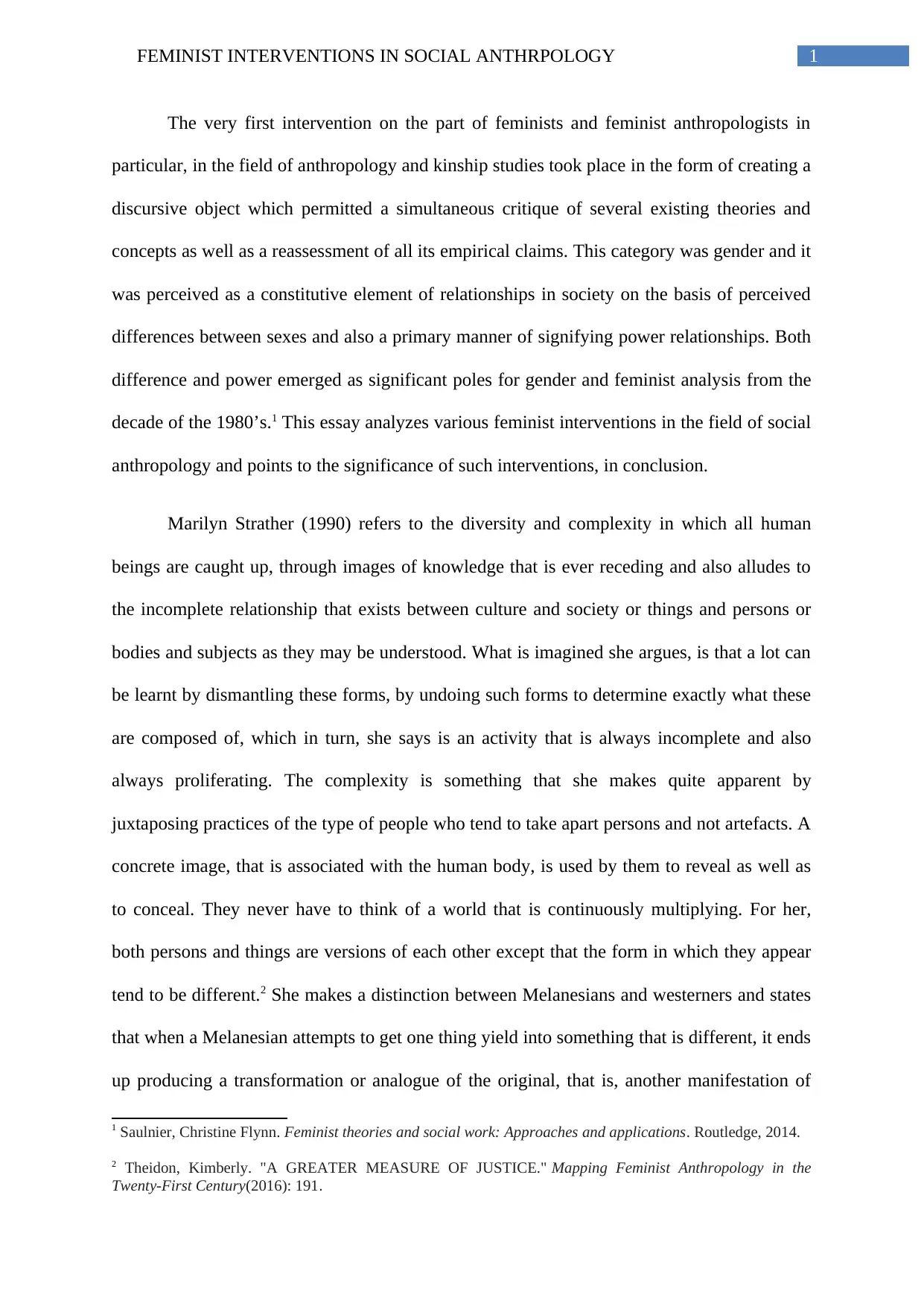
1FEMINIST INTERVENTIONS IN SOCIAL ANTHRPOLOGY
The very first intervention on the part of feminists and feminist anthropologists in
particular, in the field of anthropology and kinship studies took place in the form of creating a
discursive object which permitted a simultaneous critique of several existing theories and
concepts as well as a reassessment of all its empirical claims. This category was gender and it
was perceived as a constitutive element of relationships in society on the basis of perceived
differences between sexes and also a primary manner of signifying power relationships. Both
difference and power emerged as significant poles for gender and feminist analysis from the
decade of the 1980’s.1 This essay analyzes various feminist interventions in the field of social
anthropology and points to the significance of such interventions, in conclusion.
Marilyn Strather (1990) refers to the diversity and complexity in which all human
beings are caught up, through images of knowledge that is ever receding and also alludes to
the incomplete relationship that exists between culture and society or things and persons or
bodies and subjects as they may be understood. What is imagined she argues, is that a lot can
be learnt by dismantling these forms, by undoing such forms to determine exactly what these
are composed of, which in turn, she says is an activity that is always incomplete and also
always proliferating. The complexity is something that she makes quite apparent by
juxtaposing practices of the type of people who tend to take apart persons and not artefacts. A
concrete image, that is associated with the human body, is used by them to reveal as well as
to conceal. They never have to think of a world that is continuously multiplying. For her,
both persons and things are versions of each other except that the form in which they appear
tend to be different.2 She makes a distinction between Melanesians and westerners and states
that when a Melanesian attempts to get one thing yield into something that is different, it ends
up producing a transformation or analogue of the original, that is, another manifestation of
1 Saulnier, Christine Flynn. Feminist theories and social work: Approaches and applications. Routledge, 2014.
2 Theidon, Kimberly. "A GREATER MEASURE OF JUSTICE." Mapping Feminist Anthropology in the
Twenty-First Century(2016): 191.
The very first intervention on the part of feminists and feminist anthropologists in
particular, in the field of anthropology and kinship studies took place in the form of creating a
discursive object which permitted a simultaneous critique of several existing theories and
concepts as well as a reassessment of all its empirical claims. This category was gender and it
was perceived as a constitutive element of relationships in society on the basis of perceived
differences between sexes and also a primary manner of signifying power relationships. Both
difference and power emerged as significant poles for gender and feminist analysis from the
decade of the 1980’s.1 This essay analyzes various feminist interventions in the field of social
anthropology and points to the significance of such interventions, in conclusion.
Marilyn Strather (1990) refers to the diversity and complexity in which all human
beings are caught up, through images of knowledge that is ever receding and also alludes to
the incomplete relationship that exists between culture and society or things and persons or
bodies and subjects as they may be understood. What is imagined she argues, is that a lot can
be learnt by dismantling these forms, by undoing such forms to determine exactly what these
are composed of, which in turn, she says is an activity that is always incomplete and also
always proliferating. The complexity is something that she makes quite apparent by
juxtaposing practices of the type of people who tend to take apart persons and not artefacts. A
concrete image, that is associated with the human body, is used by them to reveal as well as
to conceal. They never have to think of a world that is continuously multiplying. For her,
both persons and things are versions of each other except that the form in which they appear
tend to be different.2 She makes a distinction between Melanesians and westerners and states
that when a Melanesian attempts to get one thing yield into something that is different, it ends
up producing a transformation or analogue of the original, that is, another manifestation of
1 Saulnier, Christine Flynn. Feminist theories and social work: Approaches and applications. Routledge, 2014.
2 Theidon, Kimberly. "A GREATER MEASURE OF JUSTICE." Mapping Feminist Anthropology in the
Twenty-First Century(2016): 191.
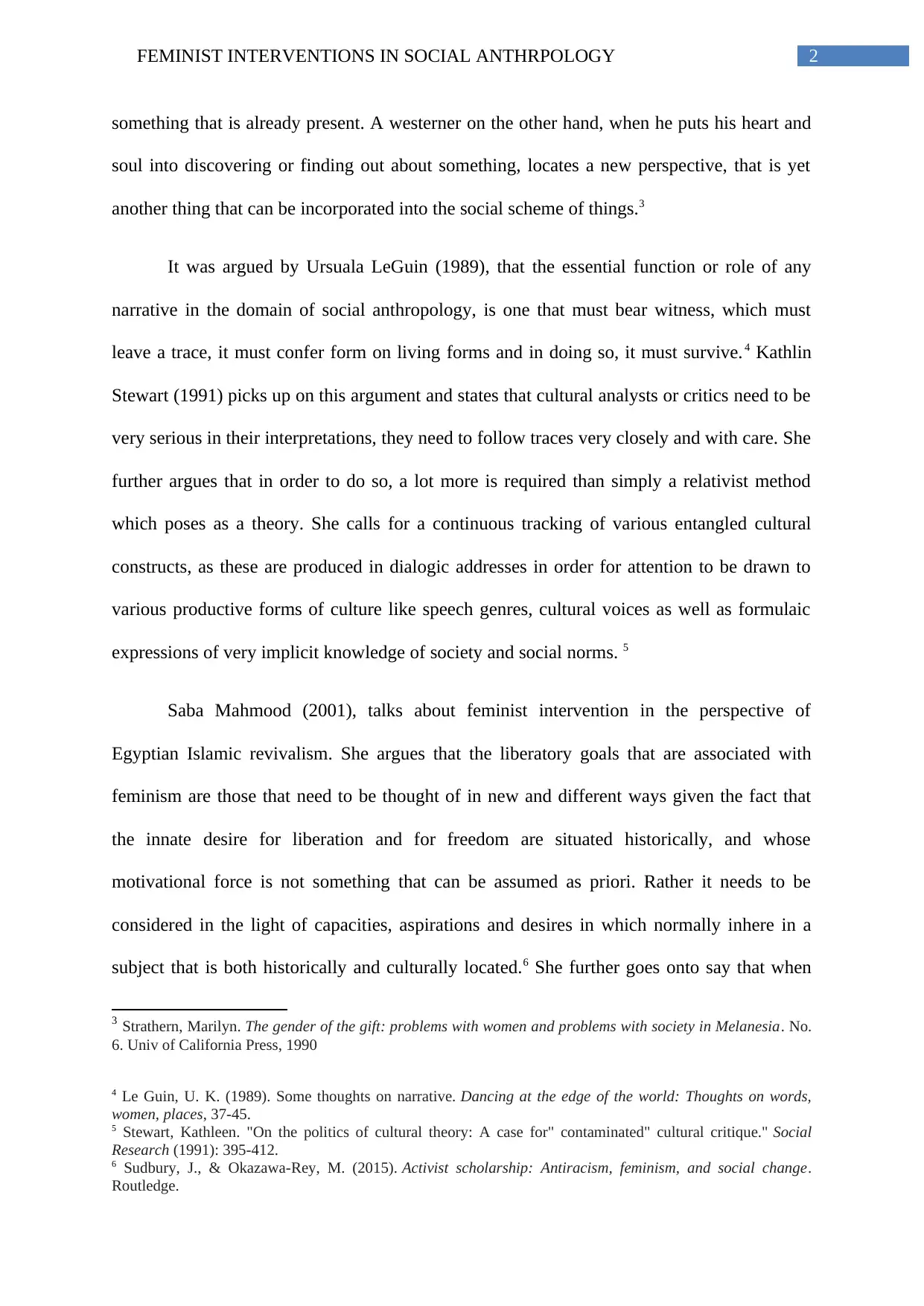
2FEMINIST INTERVENTIONS IN SOCIAL ANTHRPOLOGY
something that is already present. A westerner on the other hand, when he puts his heart and
soul into discovering or finding out about something, locates a new perspective, that is yet
another thing that can be incorporated into the social scheme of things.3
It was argued by Ursuala LeGuin (1989), that the essential function or role of any
narrative in the domain of social anthropology, is one that must bear witness, which must
leave a trace, it must confer form on living forms and in doing so, it must survive.4 Kathlin
Stewart (1991) picks up on this argument and states that cultural analysts or critics need to be
very serious in their interpretations, they need to follow traces very closely and with care. She
further argues that in order to do so, a lot more is required than simply a relativist method
which poses as a theory. She calls for a continuous tracking of various entangled cultural
constructs, as these are produced in dialogic addresses in order for attention to be drawn to
various productive forms of culture like speech genres, cultural voices as well as formulaic
expressions of very implicit knowledge of society and social norms. 5
Saba Mahmood (2001), talks about feminist intervention in the perspective of
Egyptian Islamic revivalism. She argues that the liberatory goals that are associated with
feminism are those that need to be thought of in new and different ways given the fact that
the innate desire for liberation and for freedom are situated historically, and whose
motivational force is not something that can be assumed as priori. Rather it needs to be
considered in the light of capacities, aspirations and desires in which normally inhere in a
subject that is both historically and culturally located.6 She further goes onto say that when
3 Strathern, Marilyn. The gender of the gift: problems with women and problems with society in Melanesia. No.
6. Univ of California Press, 1990
4 Le Guin, U. K. (1989). Some thoughts on narrative. Dancing at the edge of the world: Thoughts on words,
women, places, 37-45.
5 Stewart, Kathleen. "On the politics of cultural theory: A case for" contaminated" cultural critique." Social
Research (1991): 395-412.
6 Sudbury, J., & Okazawa-Rey, M. (2015). Activist scholarship: Antiracism, feminism, and social change.
Routledge.
something that is already present. A westerner on the other hand, when he puts his heart and
soul into discovering or finding out about something, locates a new perspective, that is yet
another thing that can be incorporated into the social scheme of things.3
It was argued by Ursuala LeGuin (1989), that the essential function or role of any
narrative in the domain of social anthropology, is one that must bear witness, which must
leave a trace, it must confer form on living forms and in doing so, it must survive.4 Kathlin
Stewart (1991) picks up on this argument and states that cultural analysts or critics need to be
very serious in their interpretations, they need to follow traces very closely and with care. She
further argues that in order to do so, a lot more is required than simply a relativist method
which poses as a theory. She calls for a continuous tracking of various entangled cultural
constructs, as these are produced in dialogic addresses in order for attention to be drawn to
various productive forms of culture like speech genres, cultural voices as well as formulaic
expressions of very implicit knowledge of society and social norms. 5
Saba Mahmood (2001), talks about feminist intervention in the perspective of
Egyptian Islamic revivalism. She argues that the liberatory goals that are associated with
feminism are those that need to be thought of in new and different ways given the fact that
the innate desire for liberation and for freedom are situated historically, and whose
motivational force is not something that can be assumed as priori. Rather it needs to be
considered in the light of capacities, aspirations and desires in which normally inhere in a
subject that is both historically and culturally located.6 She further goes onto say that when
3 Strathern, Marilyn. The gender of the gift: problems with women and problems with society in Melanesia. No.
6. Univ of California Press, 1990
4 Le Guin, U. K. (1989). Some thoughts on narrative. Dancing at the edge of the world: Thoughts on words,
women, places, 37-45.
5 Stewart, Kathleen. "On the politics of cultural theory: A case for" contaminated" cultural critique." Social
Research (1991): 395-412.
6 Sudbury, J., & Okazawa-Rey, M. (2015). Activist scholarship: Antiracism, feminism, and social change.
Routledge.
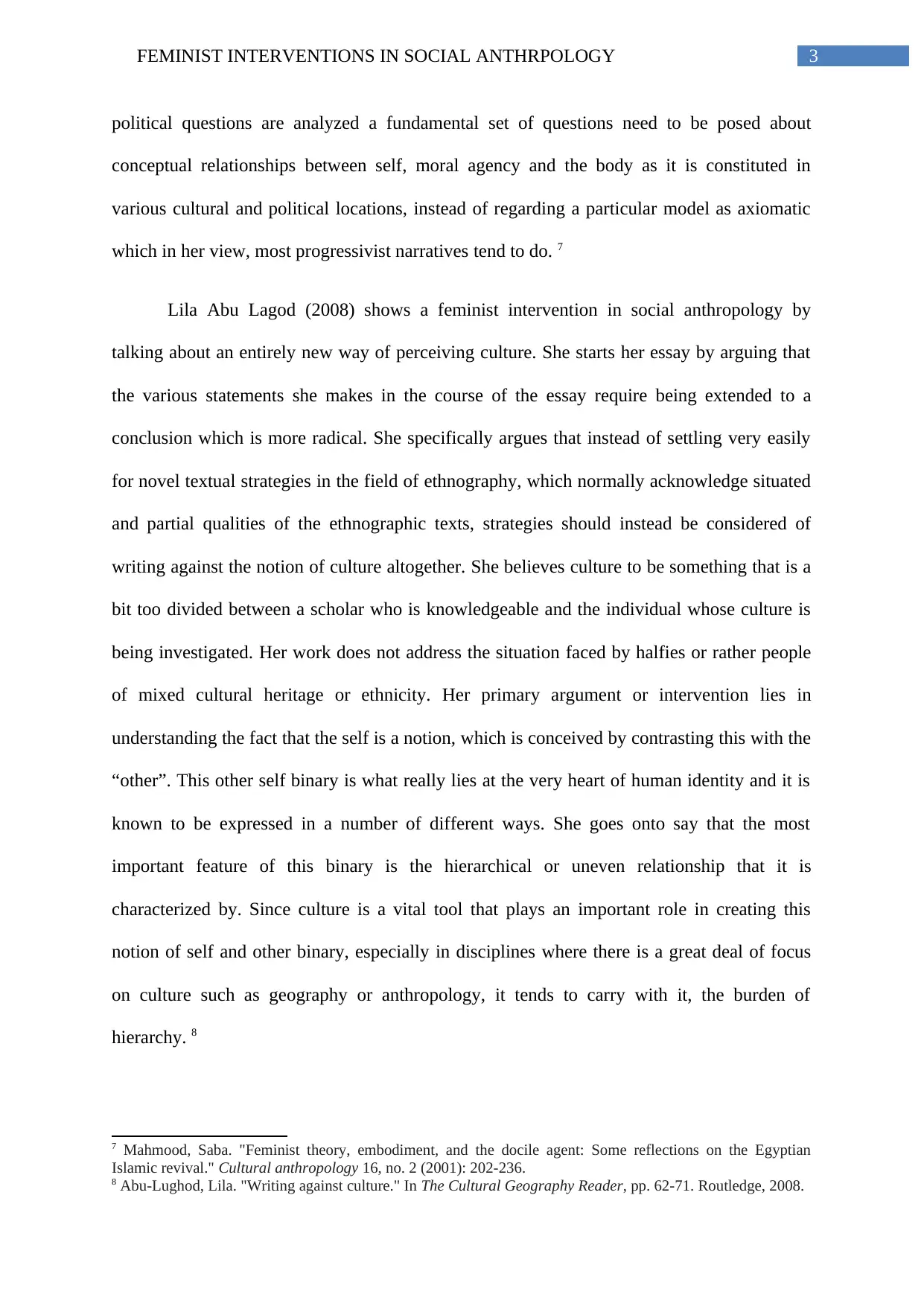
3FEMINIST INTERVENTIONS IN SOCIAL ANTHRPOLOGY
political questions are analyzed a fundamental set of questions need to be posed about
conceptual relationships between self, moral agency and the body as it is constituted in
various cultural and political locations, instead of regarding a particular model as axiomatic
which in her view, most progressivist narratives tend to do. 7
Lila Abu Lagod (2008) shows a feminist intervention in social anthropology by
talking about an entirely new way of perceiving culture. She starts her essay by arguing that
the various statements she makes in the course of the essay require being extended to a
conclusion which is more radical. She specifically argues that instead of settling very easily
for novel textual strategies in the field of ethnography, which normally acknowledge situated
and partial qualities of the ethnographic texts, strategies should instead be considered of
writing against the notion of culture altogether. She believes culture to be something that is a
bit too divided between a scholar who is knowledgeable and the individual whose culture is
being investigated. Her work does not address the situation faced by halfies or rather people
of mixed cultural heritage or ethnicity. Her primary argument or intervention lies in
understanding the fact that the self is a notion, which is conceived by contrasting this with the
“other”. This other self binary is what really lies at the very heart of human identity and it is
known to be expressed in a number of different ways. She goes onto say that the most
important feature of this binary is the hierarchical or uneven relationship that it is
characterized by. Since culture is a vital tool that plays an important role in creating this
notion of self and other binary, especially in disciplines where there is a great deal of focus
on culture such as geography or anthropology, it tends to carry with it, the burden of
hierarchy. 8
7 Mahmood, Saba. "Feminist theory, embodiment, and the docile agent: Some reflections on the Egyptian
Islamic revival." Cultural anthropology 16, no. 2 (2001): 202-236.
8 Abu-Lughod, Lila. "Writing against culture." In The Cultural Geography Reader, pp. 62-71. Routledge, 2008.
political questions are analyzed a fundamental set of questions need to be posed about
conceptual relationships between self, moral agency and the body as it is constituted in
various cultural and political locations, instead of regarding a particular model as axiomatic
which in her view, most progressivist narratives tend to do. 7
Lila Abu Lagod (2008) shows a feminist intervention in social anthropology by
talking about an entirely new way of perceiving culture. She starts her essay by arguing that
the various statements she makes in the course of the essay require being extended to a
conclusion which is more radical. She specifically argues that instead of settling very easily
for novel textual strategies in the field of ethnography, which normally acknowledge situated
and partial qualities of the ethnographic texts, strategies should instead be considered of
writing against the notion of culture altogether. She believes culture to be something that is a
bit too divided between a scholar who is knowledgeable and the individual whose culture is
being investigated. Her work does not address the situation faced by halfies or rather people
of mixed cultural heritage or ethnicity. Her primary argument or intervention lies in
understanding the fact that the self is a notion, which is conceived by contrasting this with the
“other”. This other self binary is what really lies at the very heart of human identity and it is
known to be expressed in a number of different ways. She goes onto say that the most
important feature of this binary is the hierarchical or uneven relationship that it is
characterized by. Since culture is a vital tool that plays an important role in creating this
notion of self and other binary, especially in disciplines where there is a great deal of focus
on culture such as geography or anthropology, it tends to carry with it, the burden of
hierarchy. 8
7 Mahmood, Saba. "Feminist theory, embodiment, and the docile agent: Some reflections on the Egyptian
Islamic revival." Cultural anthropology 16, no. 2 (2001): 202-236.
8 Abu-Lughod, Lila. "Writing against culture." In The Cultural Geography Reader, pp. 62-71. Routledge, 2008.
Paraphrase This Document
Need a fresh take? Get an instant paraphrase of this document with our AI Paraphraser
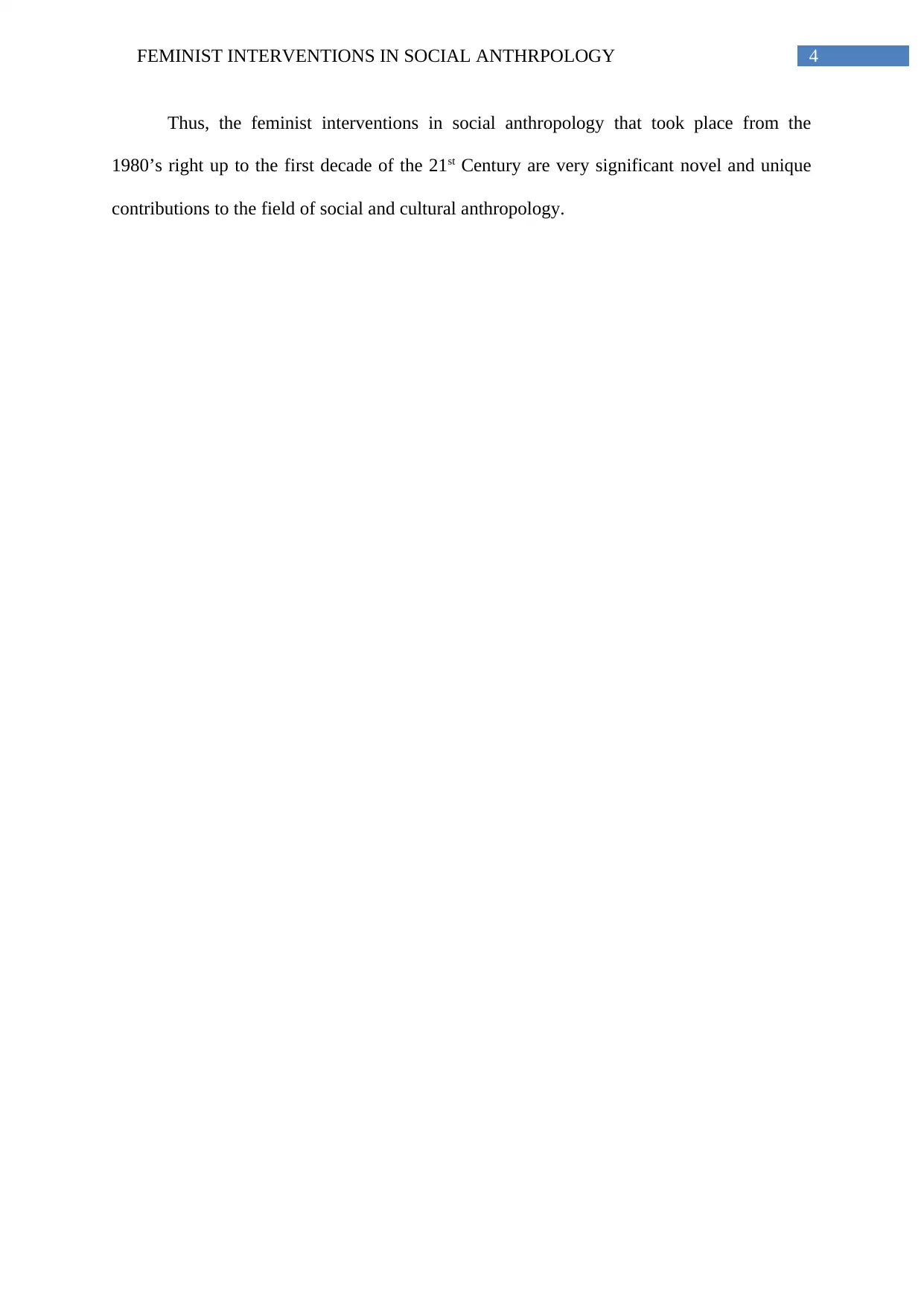
4FEMINIST INTERVENTIONS IN SOCIAL ANTHRPOLOGY
Thus, the feminist interventions in social anthropology that took place from the
1980’s right up to the first decade of the 21st Century are very significant novel and unique
contributions to the field of social and cultural anthropology.
Thus, the feminist interventions in social anthropology that took place from the
1980’s right up to the first decade of the 21st Century are very significant novel and unique
contributions to the field of social and cultural anthropology.
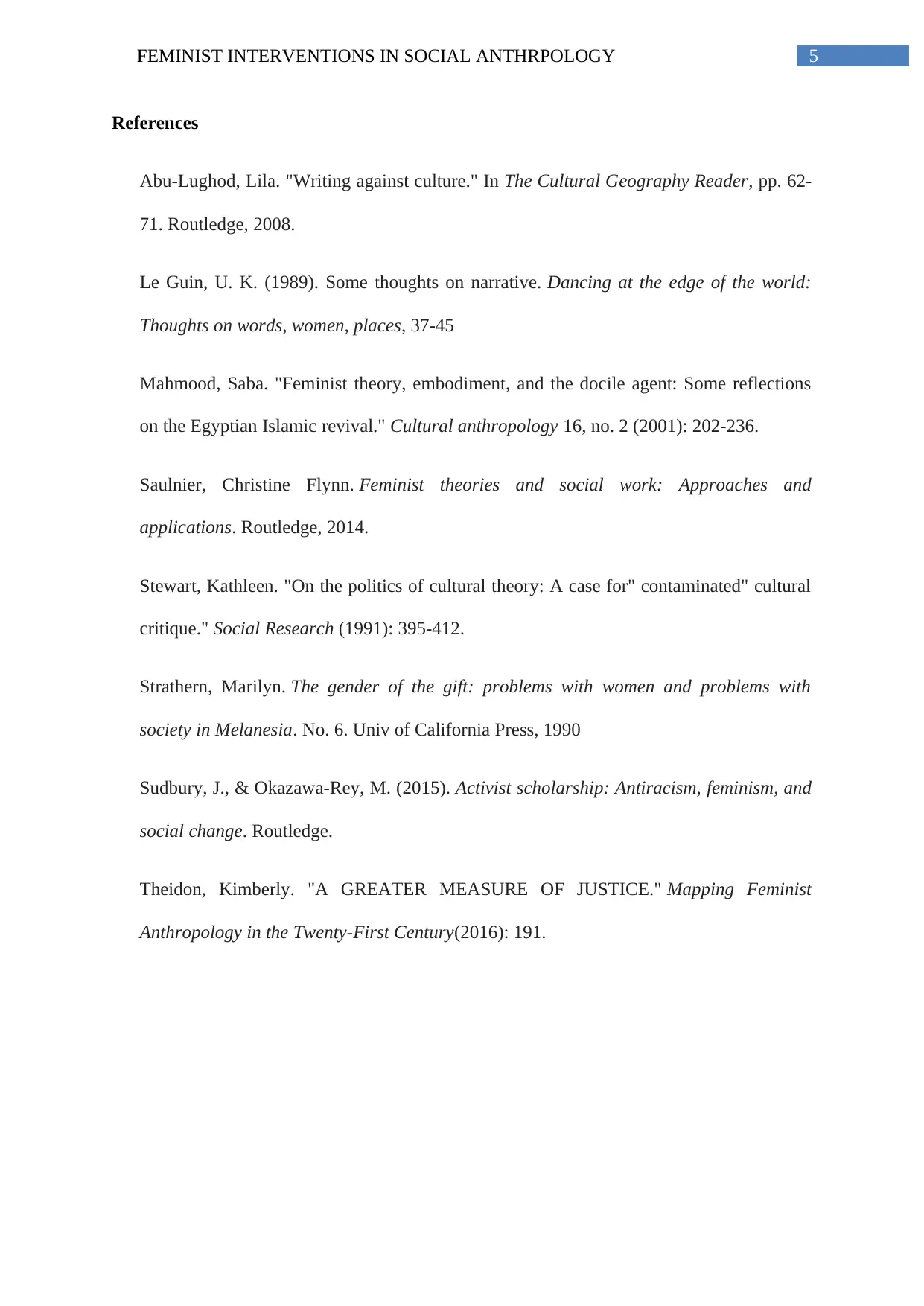
5FEMINIST INTERVENTIONS IN SOCIAL ANTHRPOLOGY
References
Abu-Lughod, Lila. "Writing against culture." In The Cultural Geography Reader, pp. 62-
71. Routledge, 2008.
Le Guin, U. K. (1989). Some thoughts on narrative. Dancing at the edge of the world:
Thoughts on words, women, places, 37-45
Mahmood, Saba. "Feminist theory, embodiment, and the docile agent: Some reflections
on the Egyptian Islamic revival." Cultural anthropology 16, no. 2 (2001): 202-236.
Saulnier, Christine Flynn. Feminist theories and social work: Approaches and
applications. Routledge, 2014.
Stewart, Kathleen. "On the politics of cultural theory: A case for" contaminated" cultural
critique." Social Research (1991): 395-412.
Strathern, Marilyn. The gender of the gift: problems with women and problems with
society in Melanesia. No. 6. Univ of California Press, 1990
Sudbury, J., & Okazawa-Rey, M. (2015). Activist scholarship: Antiracism, feminism, and
social change. Routledge.
Theidon, Kimberly. "A GREATER MEASURE OF JUSTICE." Mapping Feminist
Anthropology in the Twenty-First Century(2016): 191.
References
Abu-Lughod, Lila. "Writing against culture." In The Cultural Geography Reader, pp. 62-
71. Routledge, 2008.
Le Guin, U. K. (1989). Some thoughts on narrative. Dancing at the edge of the world:
Thoughts on words, women, places, 37-45
Mahmood, Saba. "Feminist theory, embodiment, and the docile agent: Some reflections
on the Egyptian Islamic revival." Cultural anthropology 16, no. 2 (2001): 202-236.
Saulnier, Christine Flynn. Feminist theories and social work: Approaches and
applications. Routledge, 2014.
Stewart, Kathleen. "On the politics of cultural theory: A case for" contaminated" cultural
critique." Social Research (1991): 395-412.
Strathern, Marilyn. The gender of the gift: problems with women and problems with
society in Melanesia. No. 6. Univ of California Press, 1990
Sudbury, J., & Okazawa-Rey, M. (2015). Activist scholarship: Antiracism, feminism, and
social change. Routledge.
Theidon, Kimberly. "A GREATER MEASURE OF JUSTICE." Mapping Feminist
Anthropology in the Twenty-First Century(2016): 191.
1 out of 6
![[object Object]](/_next/static/media/star-bottom.7253800d.svg)





